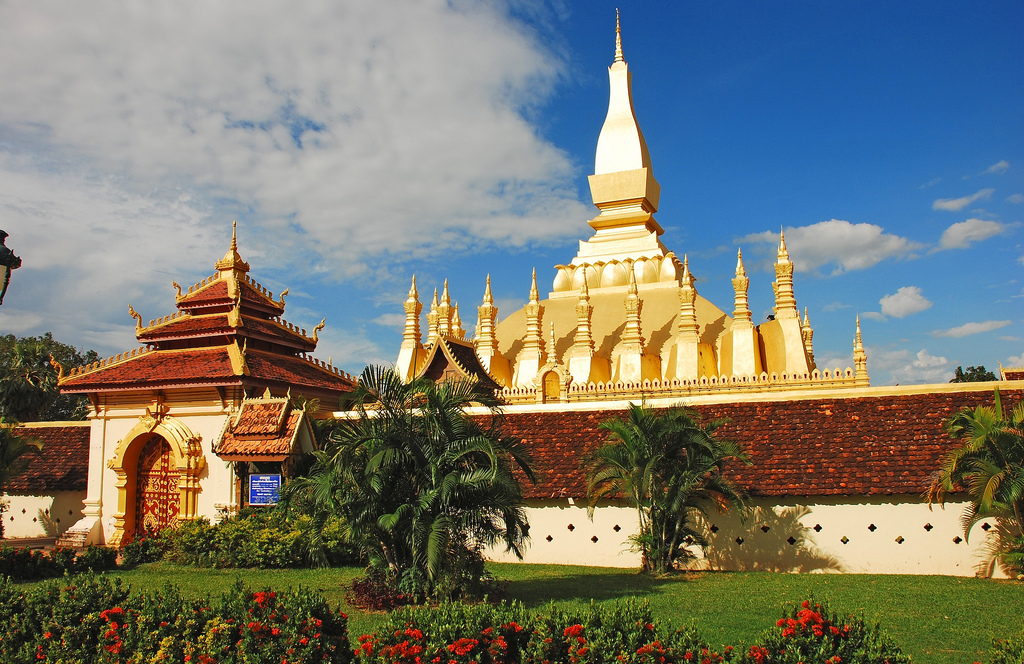Pha That Luang is a gold-covered large Buddhist stupa in the centre of the city of Vientiane, Laos. Since its initial establishment, suggested to be in the 3rd century, the stupa has undergone several reconstructions as recently as the 1930s due to foreign invasions of the area. It is generally regarded as the most important national monument in Laos and a national symbol.
Shrine’s History
Buddhist missionaries from the Mauryan Empire are believed to have been sent by the Emperor Ashoka, including Bury Chan or Praya Chanthabury Pasithisak and five Arahata monks who brought a holy relic (believed to be the breastbone) of Lord Buddha to the stupa. It was rebuilt in the 13th century as a Khmer temple which fell into ruin.
In the mid-16th century, King Setthathirat relocated his capital from Luang Prabang to Vientiane and ordered the construction of Pha That Luang in 1566. It was rebuilt about 4 km from the centre of Vientiane at the end of Pha That Luang Road and named Pha That Luang. The bases had a length of 69 metres each and was 45 metres high, and was surrounded by 30 small Stupas.
In 1641, a Dutch envoy of the Dutch East India Company, Gerrit van Wuysthoff, visited Vientiane and was received by King Sourigna Vongsa at the temple, where he was, reportedly, received in a magnificent ceremony. He wrote that he was particularly impressed by the “enormous pyramid and the top was covered with gold leaf weighing about a thousand pounds”. However, the stupa was repeatedly plundered by the Burmese, Siamese and Chinese.
Pha That Luang was destroyed by the Thai invasion in 1828, which left it heavily damaged and abandoned. It was not until 1900 that the French restored to its original design based on the detailed drawings from 1867 by the French architect and explorer Louis Delaporte. However the first attempt to restore it was unsuccessful and it had to be redesigned and then reconstructed in the 1930s. During the Franco-Thai War, Pha That Luang was heavily damaged during a Thai air raid. After the end of World War II, the Pha That Luang was reconstructed.
Pha That Luang is the most important national symbol of Laos. Buddhist missionaries from the Mauryan Empire are believed to have been sent by the Emperor Ashoka, including Bury Chan or Praya Chanthabury Pasithisak and five Arahata monks who brought a holy relic (believed to be the breastbone) of Buddha to the stupa.
Architectural Relevance of This Shrine
The architecture of the building includes many references to Lao culture and identity, and so has become a symbol of Lao nationalism.
{picture here}
The first level is 223 feet (67 metres) by 226 feet (68 metres); the second is 157 feet (47 metres) along each side; and the third level is 98 feet (29 metres) along each side.[3] From ground to pinnacle, the Pha That Luang is 147.6 feet (44 metres) high.
Only the pinnacle is covered in real gold, the remainder of the stupa is painted a gold color. The area around Pha That Luang is now gated, to keep traffic out. Previously visitors could drive around the whole complex. The encircling walls are roughly 279 feet (85 metres) long on each side and contain many Lao and Khmer sculptures including one of Jayavarman VII.
Shrine’s Map Location and How to Go There
BY ROAD
The shrine is located about 5 km northeast of central Vientiane at the end of Pha That Luang Road.
BY RAIL
The nearest railway station is the Ban Phlu Ta Luang railway station located in Phlu Ta Luang Subdistrict, Sattahip District, Chon Buri.
BY AIR
The nearest airport is the Vientiane Airport
The shrine is open between 8:00 AM and 4:00 PM.
Events Celebrated at This Shrine
“Boun That Luang” (Also called the Luang festival) is held here for three days during the full moon of the twelfth lunar month (November).
Extra Information About this Shrine
Monks and laypeople from all over Laos congregate to celebrate the Luang festival with three days of religious ceremony followed by a week of festivities, day and night. The procession of laypeople begins at Wat Si Muang in the city center and proceeds to That Luang to make offerings to the monks in order to accumulate merit for rebirth into a better life. The religious part concludes as laypeople, carrying incense and candles as offerings, circulate That Luang three times in honor of Buddha. Folk and popular music troupes and drama performances provide entertainment at the festival.
